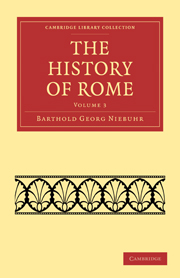Book contents
- Frontmatter
- PREFACE
- Contents
- The Licinian Rogations
- The new curule Dignities of the year 384
- Internal History down to the complete establishment of the plebeian Consulship
- On the Uncial Rate of Interest
- History of the Wars from 384 to 406
- Rome in Alliance with Latium
- The earliest Constitution of the manipular Legion
- The first Samnite War
- The Latin War
- The Laws of the Dictator Q. Publilius
- Internal History down to the Caudine Peace
- Alexander of Epirus
- Forein Relations down to the second Samnite War
- The second Samnite War
- Relations between Rome and the Nations bordering on Samnium after the Peace
- The Etruscan Wars down to the beginning of the third Samnite War
- Internal History from the Caudine Peace down to the third Samnite War
- Cn. Flavius
- The Censorship of Q. Fabius and P. Decius
- The Ogulnian Law
- Various Occurrences of the same Period
- The third Samnite War and the Others of the same Period
- Internal History from the Beginning of the second Samnite War down to the Lucanian
- Miscellaneous Occurrences of the same Period
- The Etruscan and Gallic War
- The Lucanian, Bruttian, fourth Samnite, and Tarentine Wars
- Epirus and Pyrrhus
- The Roman and Macedonian Tactics
- The War with Pyrrhus
- Entire Subjugation of Italy, and the Political Rights of the Italian Allies
- Internal History and Miscellaneous Occurrences of the Period from the Lucanian down to the first Punic War
- The first Punic War
- Index
- ERRATA
The Latin War
Published online by Cambridge University Press: 01 June 2011
- Frontmatter
- PREFACE
- Contents
- The Licinian Rogations
- The new curule Dignities of the year 384
- Internal History down to the complete establishment of the plebeian Consulship
- On the Uncial Rate of Interest
- History of the Wars from 384 to 406
- Rome in Alliance with Latium
- The earliest Constitution of the manipular Legion
- The first Samnite War
- The Latin War
- The Laws of the Dictator Q. Publilius
- Internal History down to the Caudine Peace
- Alexander of Epirus
- Forein Relations down to the second Samnite War
- The second Samnite War
- Relations between Rome and the Nations bordering on Samnium after the Peace
- The Etruscan Wars down to the beginning of the third Samnite War
- Internal History from the Caudine Peace down to the third Samnite War
- Cn. Flavius
- The Censorship of Q. Fabius and P. Decius
- The Ogulnian Law
- Various Occurrences of the same Period
- The third Samnite War and the Others of the same Period
- Internal History from the Beginning of the second Samnite War down to the Lucanian
- Miscellaneous Occurrences of the same Period
- The Etruscan and Gallic War
- The Lucanian, Bruttian, fourth Samnite, and Tarentine Wars
- Epirus and Pyrrhus
- The Roman and Macedonian Tactics
- The War with Pyrrhus
- Entire Subjugation of Italy, and the Political Rights of the Italian Allies
- Internal History and Miscellaneous Occurrences of the Period from the Lucanian down to the first Punic War
- The first Punic War
- Index
- ERRATA
Summary
The consular year began at that time in summer, about the same time as the Olympic year; it must be supposed that the campaigns generally fell in the autumn; and during the cessation of war, which winter brought, changes and revolutions were prepared. In the year 409 (414), before the Samnite peace was concluded, the consul C. Plautius marcht, still in accordance with the league, into the field against the Volscians of Privernum and Antium. The former purchast peace with two thirds of their domain land: Latium evidently received one third as well as Rome. The war was renewed with the Antiatians for the possession of Satricum; a hard won victory led to the devastation of their territory as far as the sea coast.
But when Rome had abandoned the war against Samnium in consequence of a peace, which was without any doubt contrary to the league, new connexions were of necessity soon formed. The Sidicinians were given over to the Samnites: the Campanians, after the Roman garrisons had been withdrawn, saw no safety for themselves except in the continuance of their alliance with the Latins; they were indeed, when united, strong enough to invade Samnium in the spring of the same consular year with a great army.
Latium and the Volscians of Antium, and all of the Volscian name that may have remained on the sea coast, had now given up the war and become allied to one another, like Rome and Samnium: in the same manner also the Auruncians,—the Volscians on the Liris.
- Type
- Chapter
- Information
- The History of Rome , pp. 128 - 145Publisher: Cambridge University PressPrint publication year: 2010First published in: 1842



